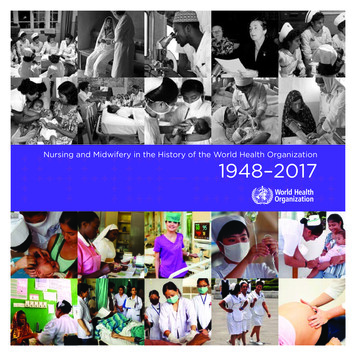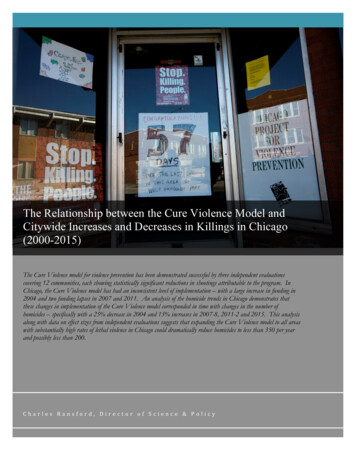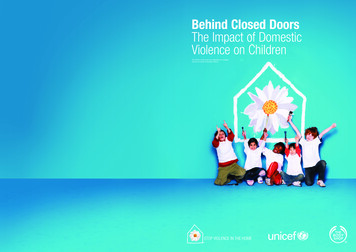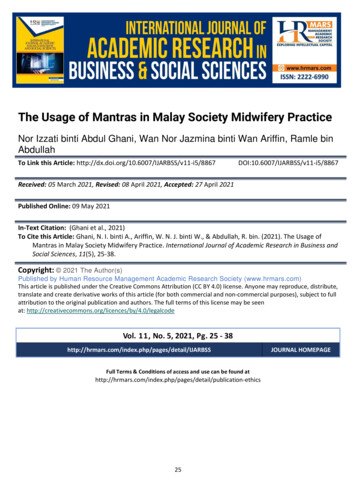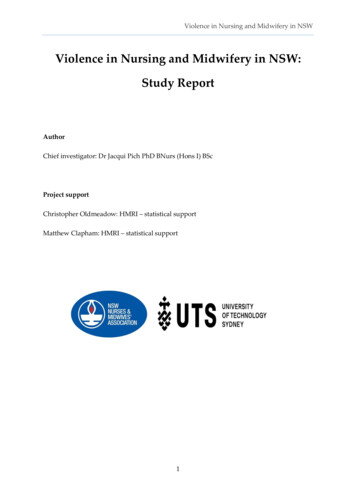
Transcription
Violence in Nursing and Midwifery in NSWViolence in Nursing and Midwifery in NSW:Study ReportAuthorChief investigator: Dr Jacqui Pich PhD BNurs (Hons I) BScProject supportChristopher Oldmeadow: HMRI – statistical supportMatthew Clapham: HMRI – statistical support1
Violence in Nursing and Midwifery in NSWExecutive summaryWorkplace violence is one of the most significant and hazardous issues faced by nurses andmidwives globally with patients the most common source of this violence. It is a potentiallylife-threatening and life-affecting workplace hazard often downplayed as just“ part of thejob”. Within this context the specialities of emergency, mental health and aged care havebeen reported to be at highest risk for episodes of violence. Violence includes a continuumof behaviours from verbal abuse and threats, sexual harassment through to physicalassaults. It involves both explicit and implicit challenges to the well-being, safety or healthof nurses and midwives at work (Mayhew & Chappell, 2005).This cross sectional study of NSW nurses and midwives utilised an online questionnaire toachieve the study objectives, and was designed to uncover the experiences of participantswith episodes of violence. The sample size of 3612 makes this one of the largest studies of itskind in Australia and globally and underscores the significance placed on the topic by NSWnurses and midwives.The data in this report demonstrate the achievement of the proposed aims and objectives ofthis study including:1. Nurse/midwife reported incidence of episodes of violence from patients and/orfamily and friends and associated outcomes in the preceding six months;2. Nurse/midwife reported incidence of the types of violent behaviours experienced;3. Compared of the experiences of NSW nurses and midwives in the private and publicsector with this violence;4. Compared the experiences of NSW nurses and midwives in metropolitan, regionaland remote areas with this violence;5. Identified the experiences of NSW nurses and midwives with this violence indifferent clinical areas and patient-related services;2
Violence in Nursing and Midwifery in NSW6. Identified the risk factors for violent episodes – including perpetrators, geographicallocation, clinical specialty;7. Identified NSW nurses’ and midwives’ perceptions of risk prevention measures andrisk management strategies adopted by their employers.While some differences were identified, the overall experiences of NSW nurses andmidwives with violence from patients and/or their relatives or friends was consistent acrossemployment sector and geographical work area. The key results of this study include:1. There were 1454 participants (1454/3101, 47%) who had experienced an episode ofviolence in the previous week and 2460 who had experienced violence in the sixmonths prior to completing the survey (2460/3092, 80%).2. The majority of nurses and midwives (81%) reported between one and 10 episodes,however 38 (2%) reported experiencing more than 10 episodes3. Older and more experienced nurses and midwives reported less episodes of violence,with younger and less experienced participants at greater risk of violence.4. Males were more likely to experience an episode of violence than females (88% to78%).5. More than half of participants working in all clinical areas had experienced anepisode of violence during the preceding six months.6. The rates of violence were highest for those working in the specialities of emergency,drug and alcohol and mental health.7. The public health sector had a higher percentage of participants having beeninvolved in violent episodes in the last six months compared to private (82%compared to 69%).8. There was a reported injury rate of 28% as a result of an episode of violence.9. Psychological injuries were the most common type of injury reported by participants,in a result that was consistent across geographical work areas and work sector.10. Participants from metropolitan areas were more likely to report a physical orpsychological injury than their regional and remote colleagues.11. Verbally abusive behaviours were experienced at higher rates by those participantsworking in the public sector.3
Violence in Nursing and Midwifery in NSW12. The majority of participants were selective in their reporting of episodes of violence,with 67% reporting only some or no episodes of violence.13. Non-physical outcomes associated with being involved in an episode of violence,and impacting on nurses and midwives’ professional role include: consideringleaving the profession, powerlessness, burnout, depression, fear of future episodes,anxiety, altered sleep patterns and reduced empathy which may affect the quality ofcare provided to patients.14. Nurses and midwives also reported a range of problems which affected theirpersonal lives following involvement in an episode of violence, some of which wereongoing in nature, for example post traumatic stress disorder (PTSD).15. There were some frequently identified nursing and midwifery behaviours associatedwith episodes of violence, many of which related to communication with patients.16. Patients who presented with substance misuse, mental health issues, alcoholintoxication and/or cognitive impairment were perceived by participants to be ofhighest risk for potential violence.17. Almost half of participants stated that they were not satisfied with their employer’simmediate response.18. Two-thirds of participants reported that they had not been provided with adequateinformation, support and follow-up following an episode of violence.19. More than half of participants had not been given access to counselling following anepisode of violence.20. Mandatory training is often not made available to staff with many having tocomplete this at their own expense outside the workplace.21. There is a reliance on online training for topics that require hands-on knowledge andpractice to be effective, for example takedown training.There is an obligation to act on the information that nurses and midwives have provided inthis study and in the words of one participant: “ please actually act on this information youcollect and improve our working conditions, Too many good nurses are being harmed and no oneseems to care ” (P198).4
Violence in Nursing and Midwifery in NSW5
Violence in Nursing and Midwifery in NSWRecommendations1. Healthcare employers in all sectors need to review current strategies and update andamend them accordingly to ensure that nurses and midwives are afforded a safework place.2. Where policies and procedures exist to protect nurses and midwives, these should beenforced and penalties imposed on employers who do not comply.3. Mandatory training should be made available for all nurses and midwives asapplicable and provided at the place of employment at the employers’ expense.Employers should be monitored regularly for compliance and appropriate actionstaken where this does not occur.4. Training should be offered in a face to face format where possible.5. Reporting of episodes of violence should be encouraged and acted on in a timelymanner by employers with feedback provided to affected nurses and midwives andconsequences for perpetrators.6. Nurses and midwives should be offered immediate and ongoing support by theiremployer following all episodes of violence.7. Nurses and midwives should be included in all planning and policy development onthe topic of violence as they represent the largest group in healthcare and are mostvulnerable to violence from patients and their relatives and friends.6
Violence in Nursing and Midwifery in NSWContentsViolence in Nursing and Midwifery in NSW: Study Report . 1Executive summary . 2Recommendations. 6List of appendices . 13Chapter 1Background . 141.1Definition of violence . 141.2Types of violence . 151.2.1Verbal abuse. 151.2.2Non-verbal hostility . 151.2.3Physical . 161.3Antecedents and precipitants . 161.3.1History of violence . 161.3.2Clinical presentations . 161.4Consequences of episodes of violence on nurses and midwives . 171.5Coping strategies. 181.5.1Debriefing. 181.6Risk management strategies . 191.7Reporting . 191.8Risk management strategies . 191.8.1Training . 197
Violence in Nursing and Midwifery in NSW1.8.2Security . 201.8.3Environmental measures . 201.8.4Policies and procedures. 211.9Conclusion . 21Chapter 2Study aims and objectives . 232.1Research question . 232.2Study aims . 232.3Study objectives . 232.4Expected Benefits and Outcomes. 242.5Advisory panel . 24Chapter 3Methods . 243.1Study Design. 243.2Study Population and Recruitment . 253.3Recruitment. 253.4Study Instrument . 253.5Promotion of the Survey . 293.6Ethical Considerations. 293.7Data Storage . 293.8Data Analysis . 30Chapter 44.1Results . 30Sampling results . 304.1.1Characteristics of participants . 308
Violence in Nursing and Midwifery in NSW4.1.24.2Composition of study sample by clinical area . 33Incidence and characteristics of episodes of violence . 334.2.1Number of episodes of violence. 374.2.2Type of violence . 374.3The consequences of episodes of violence . 464.3.14.4Injuries . 46Outcomes following an episode of violence . 494.4.1Emotional response. 494.4.2Professional responses. 524.4.3Coping strategies . 524.5Management response to episodes of violence. 534.6Reporting . 564.7Factors associated with violence – antecedents and precipitants . 584.7.1Patient specific factors . 584.7.2Staffing specific factors . 594.7.3Environmental specific factors . 614.8Risk prevention strategies . 624.8.1Training . 644.8.2Policies and procedures. 664.9Risk management . 67Chapter 55.1Discussion . 67Nurse and midwife reported incidence of episodes of violence . 689
Violence in Nursing and Midwifery in NSW5.2Injuries . 695.3Outcomes associated with episodes of violence . 695.4Factors associated with episodes of violence . 725.5Organisational risk prevention and management strategies . 735.5.1Reporting . 745.6Study strengths and limitations . 765.7Achievement of study objectives . 76Conclusions . 77Recommendations. 78Reference list . 79Appendices . 8710
Violence in Nursing and Midwifery in NSWTable of tablesTable 1: Study aims addressed in questionnaire . 27Table 2: Sampling results. 30Table 3: Characteristics of participants . 31Table 4: Study sample by clinical area . 33Table 5: Episodes of violence compared to demographic data. 34Table 6: Episodes of violence experienced by clinical area . 35Table 7: Epsiodes of violence by work sector and clinical sector . 36Table 8: Number of episodes of violence . 37Table 9: Type of verbal/non-physical violence . 39Table 10: Type of violence experienced by geographical work area . 40Table 11: Type of verbal abuse behaviours compared by work sector . 41Table 12: Types of physical violence . 43Table 13: Type of Physical violence by employment sector . 45Table 14: Type of violence and employment sector and geographical work area. . 46Table 15: Time taken off work due to injury. 47Table 16: Location of injury . 48Table 17: Type of injury . 48Table 18: Emotional responses following episodes of violence . 50Table 19: Professional responses following episodes of violence . 52Table 20: Actions effective for dealing with episodes of violence . 53Table 21: Immediate response . 5411
Violence in Nursing and Midwifery in NSWTable 22: Reporting byy work sector . 55Table 23: Reporting . 56Table 24: Reporting by work sector. . 56Table 25: Reporting mechanisms . 56Table 26: Factors that influence the reporting of episodes of violence . 57Table 27: Patient-specific factors (ranked) . 58Table 28: Age of perpetrators of violence . 58Table 29: Signs and symptoms of patients. 59Table 30: Staffing-specific factors (ranked) . 59Table 31: Nursing/midwifery activities associated with episodes of violence . 61Table 32: Environmental specific factors (ranked) . 61Table 33: Location of episodes of violence . 62Table 34: Risk prevention strategies . 63Table 35: Training . 65Table 36: Effectiveness of policies by work sector and geogrphical wok location . 66Table 37: Risk management strategies . 6712
Violence in Nursing and Midwifery in NSWList of appendicesAppendix 1: Email invitationAppendix 2: Participation Information StatementAppendix 3: QuestionnaireAppendix 4: Reminder postcard13
Violence in Nursing and Midwifery in NSWChapter 1BackgroundWorkplace violence is one of the most significant and hazardous issues faced by nursesglobally and in response the International Council of Nurses issued a position statement in2006 condemning “all forms of abuse and violence against nursing personnel” (InternationalCouncil of Nurses, 2006). It is a potentially life-threatening and life-affecting workplacehazard often downplayed as just “part of the job” (Jones & Lyneham, 2000).The Australian Institute of Criminology ranked the health industry as the most violentworkplace in the country (Perrone, 1999). According to US statistics, healthcare workers are5 to 12 times more likely to experience violence in the workplace than other workers (OSHA,2015) and they are more likely to be attacked at work than prison guards and police officers(International Council of Nurses, 2009). Nurses are at the front line of violence in hospitals,particularly those working in the specialities of emergency, aged care and mental health(Phillips, 2016). The frequency and severity of violent incidents are both said to beincreasing, however episodes of violence in healthcare remain vastly underreported (OSHA,2015).Patients are responsible for most of the violence committed against nurses, and this includespaediatric patients and their parents or carers (Gillespie et al, 2010, Pich et al, 2013).Relatives and friends, including parents and carers, who accompany patients have also beenidentified as perpetrators of violence (Jackson, Hutchinson, Luck, & Wilkes, 2013; Pich,Kable, & Hazelton, 2017) and this is particularly evident in research originating from nonwestern countries (Hasani et al., 2010; Senuzun Ergun & Karadakovan, 2005).1.1 Definition of violenceNSW Health defines violence as any incident in which an individual is abused, threatenedor assaulted and includes verbal, physical or psychological abuse, threats or otherintimidating behaviours, intentional physical attacks, aggravated assault, threats with anoffensive weapon, sexual harassment and sexual assault (SESLHD, 2018). The majority ofthis violence is service-related, that is violence that arises when providing services to clients,14
Violence in Nursing and Midwifery in NSWcustomers, patients or prisoners, perpetrated by patients or those accompanying them(SafeWork NSW, 2018).1.2 Types of violenceViolence covers a range of behaviours from verbal abuse and threats through tophysical violence.1.2.1 Verbal abuseVerbal abuse has been identified as the most common form of violence, experienced by themajority of nurses and midwives, with estimates up to 100% affected in some locations, forexample the emergency department where it can be a daily occurrence (Gacki-Smith et al.,2009; J. B. Lau, J. Magarey, & R. Wiechula, 2012).Swearing has been identified as the most common form of verbal abuse (Pich, Hazelton,Sundin, & Kable, 2011) and demeaning swearing has been identified as the most offensiveform of verbal aggression, particularly for female nurses (Stone, McMillan, Hazelton, &Clayton, 2011). Other types of verbal abuse include questioning professional skills andcapabilities; and threats: including threats of complaint or legal action (Jackson et al., 2013),and threats of violence such as shooting, killing, blowing up, punching and stabbing with aneedle (Jackson et al., 2013). Such abuse can occur face-to-face and over the phone,(Lyneham, 2000) and is not confined to the emergency department with nurses reportingthat it can occur outside the department and after working hours (Gacki-Smith et al., 2009).1.2.2 Non-verbal hostilityNon-verbal hostility refers to overt behaviours by patients designed to intimidate orthreaten nurses or gain their attention, for example crossing arms, glaring at staff, throwingtheir arms up in the air, pacing, and rolling eyes and shaking their heads while talking tostaff (Jackson et al., 2013). Other examples include acts of symbolic violence such aspunching a wall or throwing furniture (Winstanley & Whittington, 2004), and patientsphotographing or videoing staff on their mobile phones and threatening to “send it to themedia” (Jackson et al., 2013).15
Violence in Nursing and Midwifery in NSW1.2.3 PhysicalPhysical violence is defined as physical contact that is intended to injure or harm anotherparty (Nachreiner, Gerberich, Ryan, & McGovern, 2007). It includes any intentional physicalcontact, actual or threatened, and does not have to result in an injury to the victim (VictorianGovernment, 2005). The majority of physical violence occurs concurrently with verbal abuse,and this correlation may indicate that verbal violence can act as a predictor for potentialphysical violence (Lau, Magarey, & Wiechula, 2012).Examples of physical violence include being hit, slapped, kicked, pushed, choked, grabbedand sexually assaulted (Nachreiner et al., 2007; SafeWork NSW, 2018). The use of weapons,both traditional and opportunistic, is reported in the literature. Opportunistic weapons referto items readily available and used to threaten or harm nurses. Examples reported in theliterature include intravenous equipment, poles, syringes (sometimes blood-filled), furniture(Lyneham, 2000), scalpels, oxygen flow metres, ophthalmoscopes, stethoscopes and scissors(Pich, Hazelton, Sundin, & Kable, 2010).1.3 Antecedents and precipitants1.3.1 History of violenceThe greatest risk factor in predicting future violent or threatening behaviour from anindividual is reported to be a past history of violence (Ferns, 2005), and the greater themagnitude of violence, the greater the likelihood of future violence (Holleran, 2006). Thisincludes any violence the person has experienced, for example domestic abuse, assault, andany convictions for violent crime (Holleran, 2006).1.3.2 Clinical presentations1.3.2.1 Alcohol and substance misuseCrime statistics for hospital assaults in NSW for the year 2006 listed the top threeantecedents as mental health related (32% of incidents), alcohol-related incidents (31%) anddrug-related (17%) (Hilliar, 2008). Patients under the influence of alcohol and/or drugs,16
Violence in Nursing and Midwifery in NSWincluding ice, and those with mental health issues are the most likely to becomeviolent, increasing the risk to nurses by up to six times (Pich et al., 2017).1.3.2.2 Cognitive impairmentClinical diagnoses that affect cognition are linked to an increased risk for violence. Theseinclude temporary organic causes, for example intracranial trauma, delirium and hypoxia,(Chapman & Styles, 2006; Liu & Wuerker, 2005) and those that are permanent in nature, forexample dementia . Anxiety and agitation (p 0.047) and delirium (p 0.010) were found tobe statistically significant factors associated with episodes of violence in a recent Australianstudy of 537 emergency department nurses (Pich et al, 2017).1.3.2.3 Mental health issuesThe authors of an Australian study of Australian emergency departmen
Violence in Nursing and Midwifery in NSW 2 Executive summary Workplace violence is one of the most significant and hazardous issues faced by nurses and midwives globally with patients the most common source of this violence. It is a potentially life-threatening and life-affecting workplace hazard often downplayed as just part of the job.

